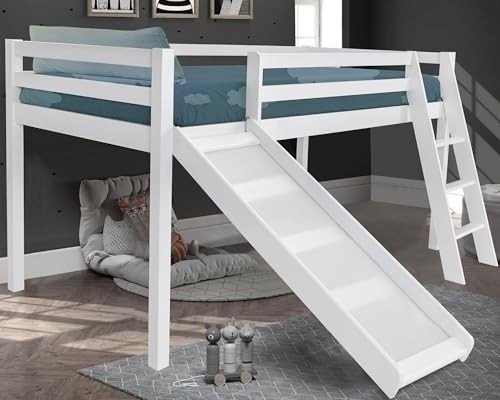30 Inspirational Quotes For Bunk Beds
Exploring Bunk Beds: A Comprehensive Guide
Bunk beds have actually long been a staple in children's bedrooms, dorms, and even homes with restricted space. Not only do they provide a useful sleeping solution, but they also develop a fun and imaginative environment for kids and a great space-saver for adults and families. This short article will check out whatever you need to understand about bunk beds, from types and products to safety ideas and buying advice.
Table of Contents
- Kinds Of Bunk Beds
- Standard Bunk Beds
- Loft Beds
- Triple Bunk Beds
- L-Shaped Bunk Beds
- Product Options
- Wood
- Metal
- Security Considerations
- Buying Guide
- Frequently asked questions
Types of Bunk Beds
Bunk beds are available in numerous styles to suit various requirements and choices. Here's a breakdown of the most common types:
Conventional Bunk Beds
Standard bunks generally include 2 beds stacked vertically on top of one another. These beds are perfect for siblings sharing a space or for making the most of sleeping space in visitor rooms.
Loft Beds
Loft beds stand similarly to standard bunk beds but do not have a lower sleeping area. Instead, they frequently include a desk or seating area beneath, making them a great choice for small spaces needing multifunctionality.
Triple Bunk Beds
Triple bunk beds are designed for 3 occupants, with beds stacked in a three-tier setup. These are less common but can be a fun option for large families or sleepovers.
L-Shaped Bunk Beds
With one bed positioned horizontally and the other vertically, L-shaped bunk beds are often geared up with additional functions such as desks or storage drawers and can complement corner areas in a room.
Contrast of Bunk Bed Types
Bed Type
Ideal Use
Description
Traditional
Shared bedrooms or visitor rooms
2 beds stacked vertically
Loft
Small spaces requiring multi-purpose space
Upper bed with open space underneath
Triple
Big households or pajama parties
Three beds stacked vertically
L-Shaped
Corner or versatile spaces
A mix of vertical and horizontal beds
Product Options
Bunk beds are produced from various materials, with wood and metal being the most common. Each product has its benefits and drawbacks.
Wood
- Resilience: Generally robust and can endure years of use.
- Visual Appeal: Offers a classic appearance that can mix with various decors.
- Weight Capacity: Typically sturdier; can support heavier weights.
- Downsides: May be more pricey than metal choices and can be prone to scratches.
Metal
- Strength: Generally lightweight and easy to move however still strong.
- Modern Design: Often is available in sleek designs, making it appealing for modern spaces.
- Cost-Effective: Usually more economical than wood alternatives.
- Downsides: Can be cold to the touch in winter seasons and might not have the same visual appeal for some buyers.
Safety Considerations
When it concerns bunk beds, security can not be neglected. Here are essential safety pointers to bear in mind:
- Guardrails: Ensure that the leading bunk has guardrails on both sides to prevent falls.
- Strong Construction: Check for a solid build and strong materials to withstand weight and motion.
- Weight Limit: Adhere to the maker's weight limitation for both the upper and lower bunks.
- Ladder Design: Choose bunks with a safe, easy-to-climb ladder and avoid any sharp edges or rungs.
- Age Restrictions: Most manufacturers recommend that kids under the age of 6 ought to not oversleep the upper bunk.
Purchasing Guide
When shopping for bunk beds, consider the list below aspects to discover the best suitable for your needs:
- Space Availability: Measure the space size and ceiling height, making sure there is appropriate space for the leading bunk.
- Bed Size: Decide between twin, full, or bigger sizes based upon your requirements and the size of the room.
- Style Preference: Consider the general decor of the bed room to discover an appropriate design.
- Alleviate of Setup: Look for a bunk bed that is uncomplicated to put together.
- Budget: Bunk beds come in various price ranges, so determine a budget before beginning your search.
Frequently asked questions
1. What is the advised age for children to sleep on the leading bunk?
Children aged 6 and older are normally suggested to sleep on the leading bunk to lessen the threat of falls.
2. How can I make my bunk bed much safer?
To improve security, guarantee guardrails are appropriately set up and check that the bed is put on a flat surface. Furthermore, encourage kids to use the ladder carefully.
3. Can I convert a bunk bed into two different beds?
Numerous bunk beds are created to be convertible. Examine try these out for convertibility features.
4. What devices are offered for bunk beds?
Common accessories consist of beddings, storage drawers, staircases instead of ladders, and tented canopies for an enjoyable visual appeal.
5. How do I maintain my bunk bed?
Routine checks for loose screws or structural integrity can help ensure security. Dust the bed routinely and clean spills immediately to keep the materials in good condition.
Bunk beds are flexible and a space-efficient service for different living situations, from kids's spaces to visitor accommodations. With lots of designs and products offered, possible purchasers have a wealth of choices to consider, ensuring a mix of usefulness and looks. By focusing on safety and following the pointers outlined in this guide, individuals can find the right bunk bed that fits their space and way of life, all while producing a pleasurable sleeping environment.
